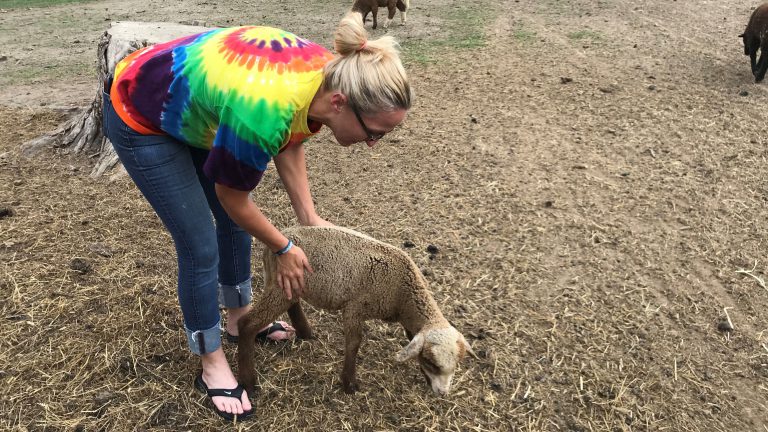When you walk into Cyndy Ash’s barn, one of the first things you notice is a huge burlap sack, bursting at the seams with wool.

“We’re sitting on about 600 lbs of wool from when they were sheared last. And it’s been sitting there since they were sheared in March,” Ash says.
Ash runs Jubilee Farms in Clinton, Ill., where she grows fruits and vegetables and raises sheep for wool, to be turned into yarn.
But, not many people are buying premium yarn in this economy. And the mill where she processes her wool wasn’t considered an essential service and only recently reopened.
“There’s really no point in us paying thousands of dollars to process wool that we can’t move right now,” she says. “Which is part of what the CFAP was hoping to help with.”
The Coronavirus Food Assistance Program (CFAP) is a U.S. Department of Agriculture (USDA) program that was launched in April to bolster the food supply chain. Part of the program involves sending a total of $16 billion in direct payments to farmers and ranchers.
But it hasn’t been helpful to farmers like Cyndy Ash.
“It doesn’t seem like the program was designed for produce farmers,” she says. “It seems like the program was really designed for corn and soybean or large livestock producers. And we don’t do any of that.”
In addition to raising sheep for wool, Ash also grows fruits and vegetables to sell at her local farmers market. But the market is closed this year due to coronavirus concerns. In need of help, Ash sought out federal aid through the Small Business Association, to no avail. She was hopeful when a friend sent her the CFAP application — until she opened it up.
The application requires a list of all crops grown and an estimated loss.
“We didn’t have a farmers market this year, so how many heads of cauliflower did I not sell? That’s a very difficult question for me to answer. How many cucumbers did I not sell? I have no idea,” Ash says.
The USDA recently added to their list of eligible crops. But some of the items Ash sells still don’t qualify, including things like eggs.
For those that do qualify, USDA pays wholesale commodity prices instead of premium prices. That means that while Ash says she could sell the wool in her barn for about $10,000, USDA would only compensate her about $200.
“I think the details of how it’s laid out make it hard for them to see an amount of funding coming out of the program that really covers what they need for the time that they’d have to put in to calculate all of those things and have all the paperwork to back it up,” says Sanaz Arjomand, Federal Policy Director for the National Young Farmers Coalition. She represents many specialty crop growers and has voiced these concerns directly to the USDA.
She adds that many specialty crop producers are young, first-generation and often farmers of color.
“Being sure that those farmers are getting the aid and support that they need and that can actually help their businesses come out on the other end, stronger, is really important,” Arjomand says.
In 2018, specialty crops accounted for about 25% of all U.S. crop receipts. As of July 20th, specialty crop growers had only received 3% of total payments. The vast majority has gone to large livestock, dairy, and corn and soybean producers.
Richard Fordyce, USDA’s Farm Service Agency Administrator, says the discrepancy in funding could be due to the fact that the program is based on losses incurred between January and April.
“That was not really a time when we saw every state would’ve had specialty crop production happening at that time,” he says. “I think that’s one reason why we’re seeing a little smaller percentage.”

Recently, lawmakers including Maine Congresswoman Chellie Pingree (D) and Nebraska Congressman Jeff Fortenberry (R) sent a letter to Agriculture Secretary Sonny Perdue asking him to include more small, diversified produce growers in the CFAP.
“The program’s rules have meant many of these farms are struggling to access relief or are entirely ineligible for assistance through this program,” the letter states.
In it, they suggest changing the program to be based on total farm revenue losses instead of individual crop losses.
FSA’s Fordyce says that wouldn’t give a full picture of what’s happening on a farm.
“I would say that not just this year, but overall, [USDA needs] to pay much more attention to the diverse farmers, produce farmers, people that are doing something other than traditional ag like corn, beans and large livestock,” says Cyndy Ash. “Those are the kind of markets that they should be supporting.”
She says it’s more than likely she’ll take a loss this year. A year she’d hoped to help her community get through the pandemic by providing healthy, local food.
Follow Dana on Twitter: @DanaHCronin
9(MDM5MjE5NTg1MDE1Mjk1MTM5NjlkMzI1ZQ000))

